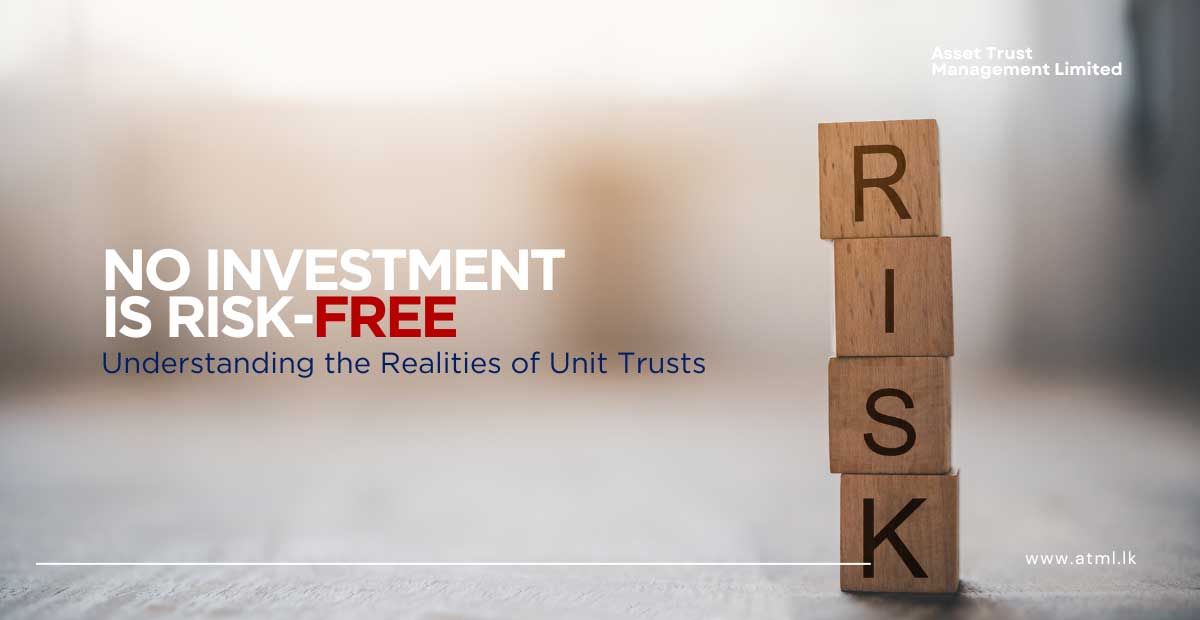No Investment Is Risk-free

No Investment Is Risk-free
Posted on 2025-01-08 17:03:12
Understanding the Realities of Unit Trusts
As an investor, it’s natural to seek opportunities that promise steady returns with minimal risk. Many potential investors look at unit trust funds as an attractive option because of their diversification and professional management. However, one key truth about investing—whether in unit trusts, stocks, bonds, or any other financial product—is that no investment is completely risk-free.
In this blog, we’ll explore why risk is an inherent part of investing and what it means for you as a potential investor in unit trust funds. Understanding the risks involved will help you make informed decisions and align your investment strategy with your financial goals and risk tolerance.
What is a Unit Trust Fund?
A unit trust fund is a collective investment scheme that pools money from various investors to invest in a diversified portfolio of assets, such as stocks, bonds, and other securities. The aim is to spread risk across different sectors and asset classes, which can reduce the impact of any single investment performing poorly. Unit trust funds are managed by professional fund managers who make investment decisions on behalf of the fund's investors.
While unit trusts are considered a relatively low-risk investment compared to individual stocks, they are not risk-free. Here’s why:
Types of Risk in Unit Trust Investments
- Market Risk (Systematic Risk)
Market risk refers to the potential for losses due to changes in the overall market conditions, such as economic downturns, inflation, interest rate hikes, or geopolitical events. Unit trust funds, even though diversified, are still affected by market-wide movements. For example, if the stock market falls sharply, the value of the unit trust’s holdings might also decline, impacting your returns.
Key takeaway: While diversification in unit trust funds helps manage this risk, it can’t eliminate it. Market risk affects almost all investments to some degree.
- Interest Rate Risk
Many unit trust funds invest in bonds and other fixed-income assets, which are sensitive to changes in interest rates. When interest rates rise, the value of existing bonds tends to fall, which can affect the overall performance of the fund. Similarly, if rates decline, bond prices can rise, potentially benefiting your investment.
Key takeaway: For investors holding unit trusts with significant bond exposure, interest rate changes can lead to volatility in returns. It’s important to understand how interest rate fluctuations might impact your investment.
- Credit Risk
Credit risk arises when a company or government entity issuing bonds or other debt instruments defaults on its obligations. A unit trust may invest in a range of bonds, some of which may be riskier than others. If a company defaults on its debt, the value of the bonds in the unit trust could decrease, affecting the fund’s overall returns.
Key takeaway: While diversified unit trusts typically reduce credit risk, the quality of the assets in the fund still matters. The risk of default is never entirely eliminated.
- Currency Risk (Foreign Exchange Risk)
Unit trust funds that invest in international markets or hold foreign assets expose investors to currency risk. If the value of the currency of the country in which the assets are held falls relative to the investor's home currency, the value of the fund's holdings can decrease, even if the underlying investments perform well.
Key takeaway: Currency fluctuations can affect the returns of unit trusts that invest in foreign assets. Be mindful of the risks involved if you’re investing in global or regional unit trust funds.
- Liquidity Risk
Liquidity risk occurs when you’re unable to sell an asset quickly without incurring a significant loss. While unit trust funds are generally liquid (meaning you can buy or sell units fairly easily), there may be times when the underlying assets in the fund are harder to sell or when markets are experiencing turmoil.
Key takeaway: While unit trusts are typically more liquid than individual stocks or private equity, market conditions can still affect their ability to sell underlying assets quickly.
- Manager Risk
The performance of a unit trust depends, to a significant extent, on the expertise and decisions of the fund manager. If the manager makes poor investment decisions or fails to adapt to changing market conditions, the fund’s returns can be affected. Even though unit trusts are professionally managed, the quality of management is still a key risk factor.
Key takeaway: It’s important to choose unit trusts that are managed by reputable and experienced fund managers. Do your research before committing to any fund.
Why Diversification Doesn’t Eliminate Risk
One of the primary reasons investors are drawn to unit trust funds is their diversification—spreading investments across different sectors, asset classes, and geographies to reduce individual risk. While diversification does help reduce the impact of poor performance from any single investment, it cannot eliminate all risks. For instance, market-wide downturns, economic recessions, or global financial crises can affect all investments, even diversified ones.
Therefore, even the most diversified unit trust funds will face some level of risk, and there’s always the possibility of losing money. Diversification simply helps manage risk, not eliminate it entirely.
Risk Tolerance: Know Your Limits
Understanding your risk tolerance is crucial when investing in unit trust funds. Everyone has a different capacity for dealing with market fluctuations, and it’s important to match your investments with your ability to withstand potential losses.
If you’re risk-averse, you might prefer conservative funds, which focus on bonds or stable dividend-paying stocks. On the other hand, if you’re willing to take on more risk for higher potential returns, you might opt for more aggressive funds with higher exposure to stocks and emerging markets.
How to Manage Risk in Unit Trust Investments
While you can’t completely eliminate risk, there are strategies to manage and mitigate it:
- Start Early: The longer you stay invested, the more time you give your investments to recover from any short-term market fluctuations.
- Regularly Review Your Investment Portfolio: Ensure your unit trust fund aligns with your goals and risk profile. As your financial situation changes, you may need to adjust your investment approach.
- Diversify Across Funds: In addition to diversifying within a single unit trust, you can spread your investments across multiple unit trusts that focus on different asset classes, sectors, and geographical regions.
- Stay Educated: Knowledge is power when it comes to managing risk. Stay informed about market trends, economic changes, and the performance of your fund. This will help you make more confident investment decisions.
Embrace Risk, But Invest Wisely
Investing in unit trusts is a smart way to gain exposure to a diversified portfolio managed by experts, but it’s important to remember that no investment is risk-free. All investments come with inherent risks, and understanding these risks will allow you to make more informed decisions.
While you cannot eliminate risk entirely, you can manage it through diversification, regular portfolio reviews, and understanding your personal risk tolerance. With these strategies in place, you’ll be better equipped to navigate the world of unit trust investments and achieve your long-term financial goals.
So, embrace the potential of unit trusts, but do so with a clear understanding of the risks involved and how to manage them.
